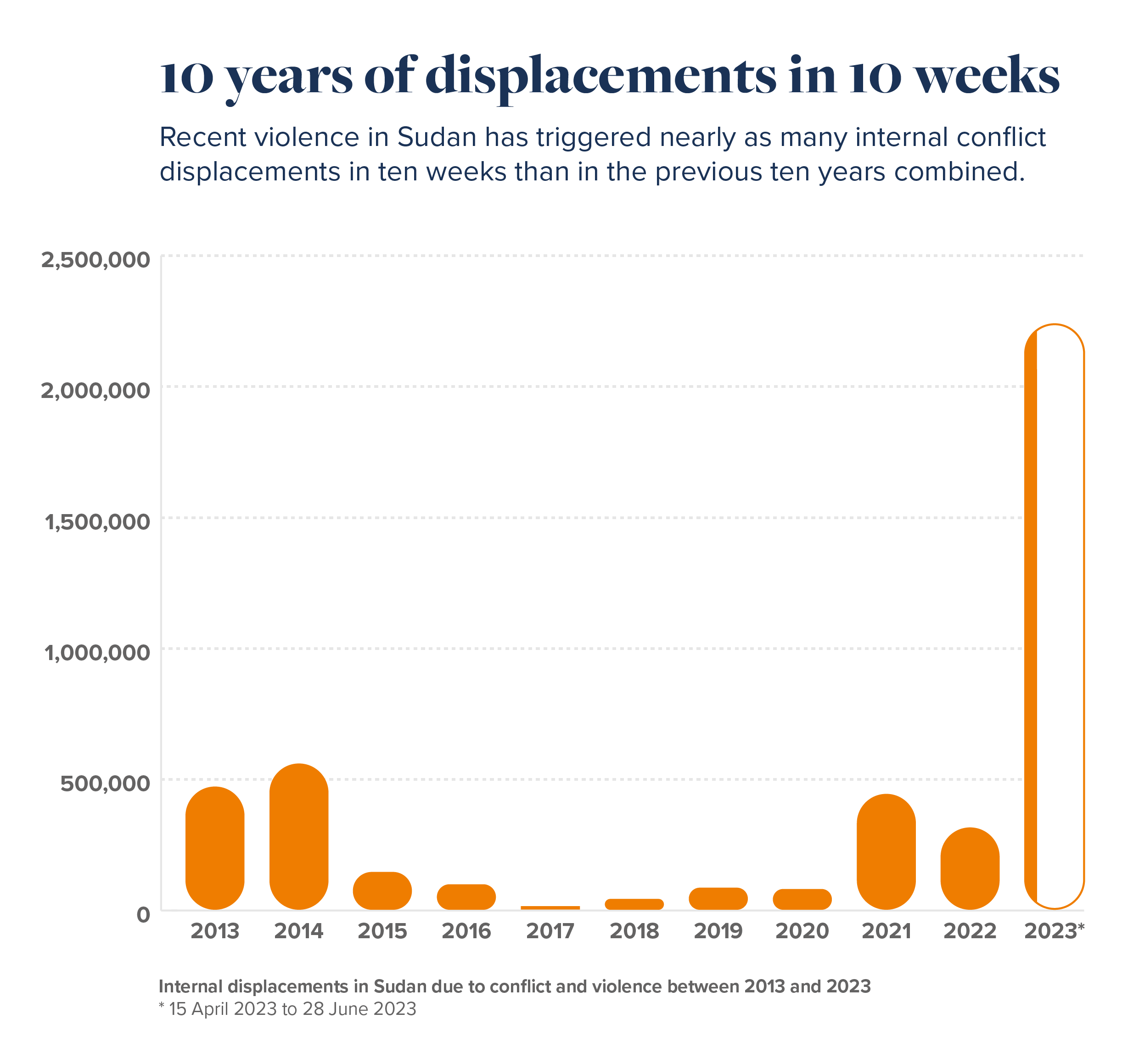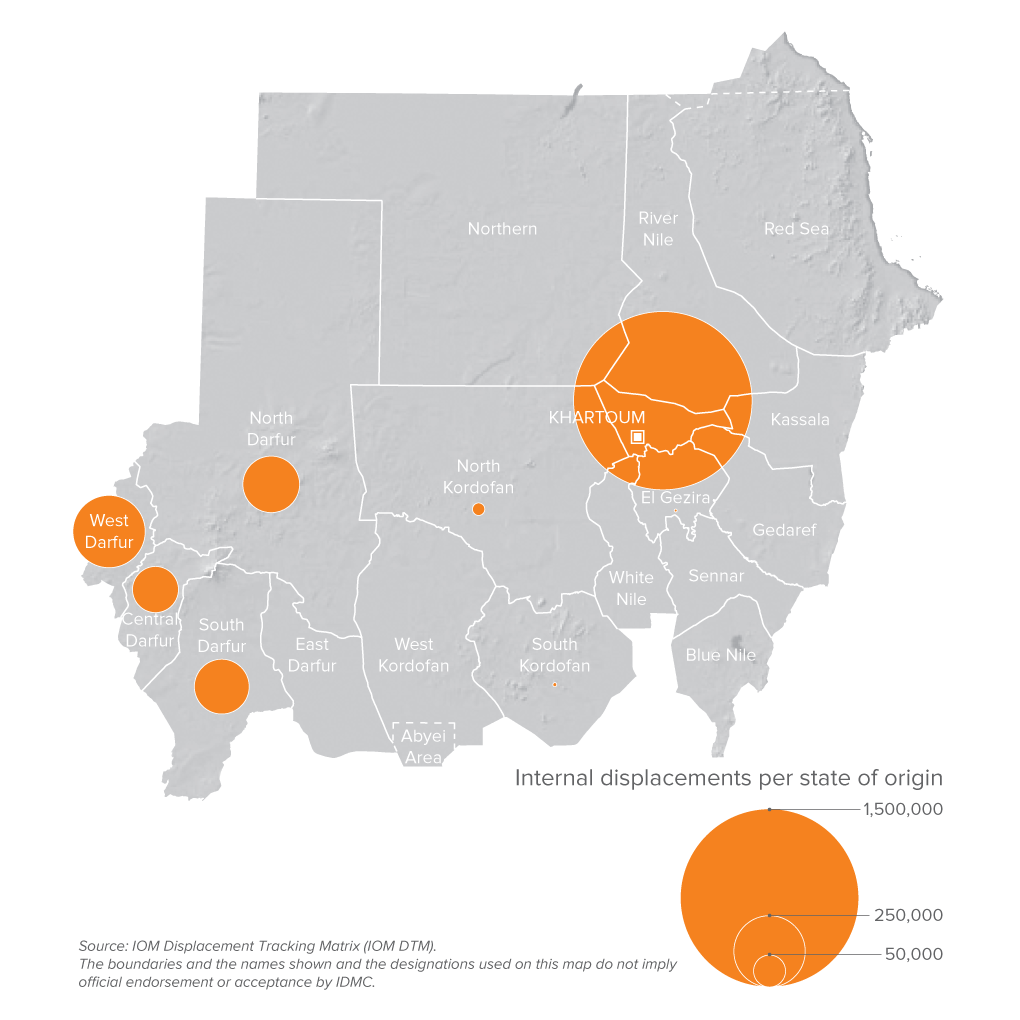
Expert analysis
12 July 2023
In Sudan, 10 years of displacements in 10 weeks
Since conflict erupted in Sudan on 15 April 2023, 2,231,523 internal displacements have been recorded in the country (as of 28 June 2023), nearly the same number of internal displacements due to conflict and violence in the country than in the previous 10 years combined (2,246,000). This is the highest internal displacement figure recorded in Sudan due to conflict and violence since IDMC started its monitoring of the country in 2008.

As of March 2023, a month before the onset of the conflict, over 3.8 million people were internally displaced across Sudan. This figure will most likely reach much higher levels at the end of this year due to the ongoing widespread conflict. However, access constraints are not allowing current data collection efforts to fully unpack how many people have been newly displaced versus how many people have been displaced a second, third, or even fourth time.
Shifting displacement dynamics: from intercommunal violence in 2022 to nationwide conflict and violence in 2023.
In 2022, internal displacements were essentially due to intercommunal violence. They mainly occurred in Blue Nile state, linked to disputes over land between Funj and Hausa tribes, and in West Darfur state, linked to disputes over land and resources between Arab and non-Arab ethnic groups. In contrast, the conflict since April 2023 is national in scope. The fighting between the Sudanese Armed Forces (SAF) and the Rapid Support Forces (RSF) in multiple locations across Sudan has resulted in millions of internal and cross-border displacements. Fighting initially took place in cities across Northern and Khartoum states, later spreading across the Darfur and Kordofan states.
Khartoum state is now at the epicentre of the latest wave of violence.

Khartoum state has been experiencing the highest levels of internal displacement, with 1,558,798 internal displacements reported since April, primarily originating in the city of Khartoum. Conversely, there were no reported displacements from Khartoum state in 2022. In Blue Nile, unlike last year, there were no internal displacements recorded originating from the state in 2023 as the Funj and the Hausa tribes signed in January 2023 an agreement in which the parties committed to refrain from violence and resolve intercommunal disputes peacefully.
The conflict reignites ethnic disputes in West Darfur resulting in repeated displacements.
Apart from Khartoum, which has seen the highest number of internal displacements, most reported displacements have occurred in West Darfur, South Darfur, Central Darfur, and North Darfur. Since April, approximately 664,033 internal displacements have been reported in these states. Darfur has experienced conflict and violence since 2003. The conflict has reignited long-standing communal tensions, especially in West Darfur, where fighting has erupted between Arab and non-Arab communities. West Darfur has reported approximately 255,855 internal displacements since April (over 11 per cent of the total for the country). The state’s capital, El Geneina, has seen the most severe level of conflict and violence outside of Khartoum, resulting in repeated displacement of thousands of individuals. The humanitarian situation in the town has worsened with attacks on civilians, water and electrical facilities, as well as hospitals.
Regional, national, and local impacts of the conflict.
The recent conflict in Sudan poses risks to neighbouring countries, including cross border displacements, weapon proliferation, and safe havens for non-state armed groups. The conflict has already displaced 697,151 people across borders into Egypt, Chad, South Sudan, Ethiopia, Central African Republic, and Libya.
River Nile state, Northern state, White Nile state, and West Darfur state have received the majority of IDPs. All IDPs within River Nile state, Northern state, and White Nile state have reportedly arrived from Khartoum state and most of them are seeking shelter with relatives in the host community. The movement of people towards these states has put pressure on the supply of food and other basic needs. At the same time, food prices have soared across the country.
The onset of the rainy season this month will likely bring additional challenges, especially in the northern areas of North Darfur, parts of South Kordofan, and most of Blue Nile, Sennar, and White Nile states where above-average rainfall is predicted this year. Combined with current conflict dynamics, the increased risk of flooding will create significant humanitarian impacts on the displaced population which sought refuge in these areas. In addition to the outbreak of waterborne diseases and other health concerns, people could also be forced into repeated displacements, having been previously displaced by conflict and violence in the past few years or in the past few weeks, or both.
The ongoing fighting is having significant impacts on the millions of civilians who are fleeing their homes, with most of the displaced population being sheltered by the host communities in urban areas. Displaced population need emergency shelter, clean water, food, health care services, psychosocial support, protection against physical attacks, and other vital assistance. The spread of diseases and malnutrition among displaced children and cases of sexual and gender-based violence continue to be reported across the country.
Looking ahead
The ongoing fighting is having significant impacts on the millions of civilians who are fleeing their homes, raising concerns over the risk of repeated displacements. The humanitarian response in Sudan continues to be underfunded, with a third of the country’s population in need of aid by the end of last year.
As of today, it is still unclear who the displaced population is, how many times they’ve been forced to flee their homes, how long they will be displaced for, and whether they will be able to return home in the coming months or years. While data collection efforts are underway, and provide an overview of the recent displacements, more assessments still need to be conducted in order to paint the full picture of the impacts of this latest conflict on the Sudanese population.
For more information visit IDMC's Country Profile for Sudan

